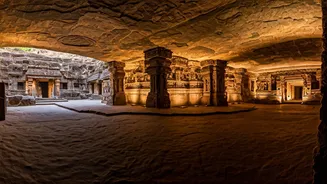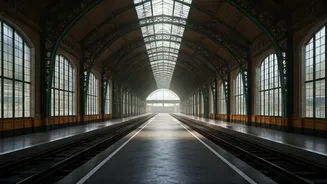Ajanta Caves: Artistry Unveiled
The Ajanta Caves stand as a remarkable testament to ancient Indian artistry. They represent a significant achievement in rock-cut architecture, showcasing
intricate paintings and sculptures that depict the life of Buddha and Jataka tales. These caves, carved into the cliffs of a gorge in Maharashtra, were created during the 2nd century BCE and the 5th century CE. The vibrant murals, employing the tempera technique, have survived for centuries, displaying a mastery of color and form. The Ajanta Caves served as monasteries and prayer halls, offering a space for Buddhist monks to practice and learn. Their rediscovery in the 19th century by British officers brought these wonders to the world's attention. Today, they are a powerful symbol of India's rich artistic heritage, attracting visitors from all corners of the globe. The caves provide a window into a time when art and spirituality flourished together, creating an enduring legacy.
Rani Ki Vav: Stepwell Splendor
Rani Ki Vav, also known as the Queen’s Stepwell, is an architectural marvel located in Patan, Gujarat. This stepwell, constructed in the 11th century by Queen Udayamati, commemorates her husband, King Bhima I. The stepwell is an inverted temple, with intricately carved sculptures of Hindu gods and goddesses, highlighting the artistry and engineering skills of the Solanki dynasty. The design consists of seven levels of stairs and pavilions that descend to the water level. Each level of Rani Ki Vav exhibits stunning carvings depicting mythological scenes and religious figures, adding to its architectural beauty. The stepwell's design included features to regulate water temperature and storage during all seasons. The structure's intricate details and spiritual significance reflect its importance as a center for religious and social gatherings. Rani Ki Vav was rediscovered in the late 19th century and has since been recognized as a UNESCO World Heritage site, admired for its exceptional architectural value.
Konark: Sun Temple's Glory
The Konark Sun Temple, situated in Odisha, is a magnificent example of Indian temple architecture. Built in the 13th century, it is dedicated to the sun god, Surya, and is designed in the form of a massive chariot pulled by horses. The temple's structure displays exquisite stone carvings that represent various aspects of daily life, mythology, and nature. It is famous for its intricate carvings, including the iconic depictions of the sun god and the impressive wheel designs, which act as sundials. The temple's architecture, including its large complex layout, demonstrates the mastery of ancient Indian engineers and artisans. The temple's sculptures are rich with detail, capturing the essence of the surrounding cultural landscape. Though partially in ruins, the Konark Sun Temple's grandeur still resonates, attracting tourists globally. The temple has now become a symbol of Odisha's cultural heritage and stands as a representation of India's artistic achievements.
Hampi: Empire's Ruins
Hampi, in Karnataka, is another UNESCO World Heritage site. This site holds the remains of the Vijayanagara Empire, showcasing its former glory through its numerous temples, palaces, and markets. The ruins cover a vast area, including impressive stone structures and intricate carvings. The Virupaksha Temple, dedicated to Lord Shiva, is among the most well-preserved and active religious sites in Hampi. The architecture of Hampi exhibits a blend of South Indian styles, including its use of granite and intricate designs. The site shows the former economic and cultural wealth of the Vijayanagara Empire, with its remains. The structures are also known for their innovative water management systems, demonstrating the sophistication of the civilization. Today, the ruins of Hampi provide a captivating glimpse into a bygone era, drawing history enthusiasts and architecture lovers from around the world to marvel at its remains.













